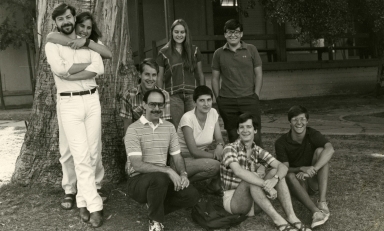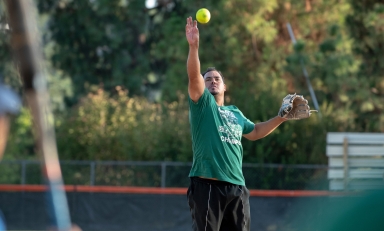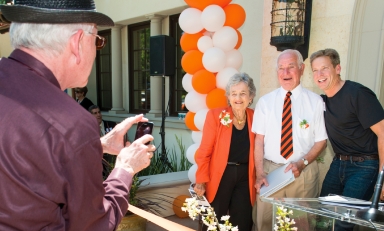
Oxy's signature buildings bear the stamp of architect Myron Hunt—but it took a landscape architect from the East to make the campus complete
By Paul Robert Walker '75
Generations of Oxy students have strolled beneath the stately oaks of the central Quadrangle and studied or chatted with friends while sitting on the tree-shaded steps and benches. During noon hours they've enjoyed another form of "Quad sitting," perched on the long, low retaining wall facing Johnson Student Center or lounging on the grassy slope behind it. It's safe to say that few students over the last 75 years have been aware that this sublime yet functional beauty was designed by one of the foremost landscape architects of the early 20th century.
Born into a wealthy New York family in 1872, Beatrix Jones studied with famed Harvard botanist Charles Sprague Sargent and in 1899—14 years before her marriage to Yale history professor Max Farrand—was the only woman among 11 founding members of the American Society of Landscape Architects. She designed some 200 private gardens during her lifetime, with a clientele that included J.P. Morgan, the Rockefellers, and the Vanderbilts. By 1936, she had also worked at an impressive array of college and universities including Princeton, Yale, Vassar, Hamilton, the University of Chicago, and Caltech. Although institutional work might not have offered the creative freedom of private gardens, Farrand strongly believed in its importance. "Surely the training of the eye to daily settings both beautiful and fit is as large a part of education as is the regular academic routine," she wrote in a 1925 article for the Yale Alumni Weekly.Farrand built her career on the East Coast before moving to Southern California in 1927, when her husband became the first director of the Huntington Library in San Marino (after the death of founder Henry E. Huntington). She traveled regularly to continue her work back East, but was frustrated by the lack of opportunity and professional respect in Southern California. She was never allowed to work in the Huntington Gardens and was treated as an unpaid volunteer during a 10-year association with Caltech, finally severing the relationship in 1938 and suggesting the school "make arrangements with some professional advisor in outdoor work."
Her association with Occidental may never have happened without the involvement of trustee Charles H. Thorne, whose 1936 gift letter tied several campus developments to his donation for the construction of Thorne Hall ("Character Building," Spring). Among his conditions, Thorne required "that the quadrangle of the interior campus be rebuilt and replanted in accordance with general schematic plans and that Mrs. Beatrice Farrand (sic), or her equal, be engaged for the detailed landscape work."
Fortunately for the College, Farrand was available, and interested. In a letter to President Remsen Bird dated Nov. 23, 1936, she laid out her fees, "based on a rate of one hundred dollars a day for my own time spent either in the field or in the office." A woman of substantial means, it was not the money that mattered, but the fact that she was setting a standard for a profession that had not yet achieved the level of respect on the West Coast that it held back East.
"As you know, I am keenly interested in the development and improvement of Occidental College and would like to help it if this seem desirable to the Trustees. The rates for professional work have been made as moderate as seemed fair to the institution and profession and its local associates," Farrand wrote Oxy trustee Alphonzo E. Bell 1895 the following April. "The possibilities latent in the campus for development on the lines of simple beauty and dignity are great and the problem a thrillingly interesting one."
By then, her work at Occidental was well underway. "When Beatrix Farrand visited the campus, people noticed," recalls professor of biology emeritus John McMenamin '40, who was a freshman (alongside his future wife, Addie Grant '40) during the College's golden-anniversary year. "She would arrive in a chauffeur-driven, open luxury car with the top down, giving her a clear view of the campus. She dressed in tailored tweeds and broad-brimmed hat and carried an umbrella used mostly as a walking stick. As she sat rigidly in the back seat of her car monitoring the progress of the landscaping, she created quite a regal sight."
When the project began, Farrand's chauffeur could have driven her Pierce Arrow up Alumni Avenue all the way to the foot of the broad steps between Fowler and Johnson halls. There, it would have met another road—a continuation of Armadale Avenue that ran past Fowler, Johnson, and Freeman Union, before splitting around the low hill where Thorne Hall would be built. A third road, parallel to Armadale, entered the campus on the western side of Mary Norton Clapp Library (where the new library wing was completed in 1971), continued past the front of Swan Hall, and extended between the back of the union and the football field (site of a present-day service road).
The long, upward slope of Alumni Avenue was the central axis of the campus in architect Myron Hunt's original plan, and the network of roads meant that students crossed streets while walking to and from class (though in practice there was little traffic). Thorne's vision required that all of these roads be closed to create a more traditional central quadrangle with a new axis, perpendicular to the old one, leading to Thorne Hall.
To accomplish this campus reorientation, four long, shallow terraces were created across the slope: the highest directly below Johnson and Fowler, the next on the level of the Armadale road, the next and widest forming the central Quad, and the lowest in front of Swan Hall. Farrand determined the designs for the terrace walls and steps, which are identifiable today by the yellowish concrete infused with rocks and the gentle, rounded "bullnosing" of the edges. A characteristic Farrand design derived from classical models, the steps are not only aesthetically pleasing but utilitarian in that the edges are less likely to break. Moreover, the gentle terracing allowed water to flow naturally downhill, as she believed that "no drainage system that has ever been evolved can carry a heavy California storm."The budget for the landscaping project was originally set at $20,000, but grew to $36,000 by August 1937. Bell, who served as chairman of the grounds committee, agreed to contribute $30,000 of the total. The lion's share of the money went to a general contractor, the Osborn Co., to reshape the land and build the steps and terraces, not only in the central Quadrangle but also in the student Quadrangle, where undergrads now "Quad sit" on one of Farrand's retaining walls and a series of her gentle steps climb toward Thorne Hall. Along with creating the quadrangles, Osborn dug a utility tunnel more than 300 feet long between Freeman Union and Thorne (inadvertently creating the stage for the practice of "tunneling," a truly underground Oxy tradition).
By the summer of 1937, the construction work was in full swing, with planting scheduled to begin that fall. Farrand's vision for the central Quad called for mature California live oaks that would immediately transform the campus. On Bell's orders, local nursery R.W. Hamsher & Co. boxed 35 trees from the Saugus area north of Los Angeles for her inspection, and Farrand chose 18 of them: four large multi-trunk specimens for the two ends of the Quad and 14 large, single-stemmed trees for the center. These trees alone cost $4,300, eating up the original planting budget and then some.
On Oct. 9, 1937, when the first two oaks arrived on campus, comptroller Fred McLain 1916 wrote to Bell to inform him of the excitement, even on a Saturday with many students having left for the weekend. "I wish you could be on the campus on Monday morning when the students return to hear their 'ohs' and 'ahs' over the size of the trees. We are all aware that the placing of these trees is really a historic moment in the progress of the college, and we are thrilled beyond words."
Farrand also designed furniture for the Quad: a pair of massive concrete benches and tables for each end of the upper terrace, and teak garden furniture to be ranged along the walks. Bell added extra funds for the concrete benches, which still face each other across the upper level of the Quad (though one was moved farther back to make room for Norris Hall of Chemistry).
The teak furniture came from an English firm that specialized in using old wood salvaged from British ships. There were four "Britannia" benches designed by Farrand, eight matching chairs, and four stools, all built from old Burmese teak, salvaged from an English passenger liner called the Armadale Castle (serendipitously enough, considering the closing of Armadale Avenue for the project). That furniture is long gone, worn by the years, but Addie and John McMenamin rescued the last two Britannia benches in the early 1960s and later reconstructed them into a single bench that they still enjoy in retirement in Oceanside.
Farrand devoted substantial thought to the area around Thorne Hall, where she insisted that the architects "marry" the level of the building to the slope on which it was being built and defined the positioning of steps, walls, and ramps. At Thorne's expense, she placed four 50-year-old olive trees in the flagstone-paved forecourt to shade afternoon theatergoers. She also obtained large agaves from the Huntington Gardens for the east side of the building and planted white wisteria atop a wall to the rear. After her work on Thorne Hall was completed, Farrand went on to design the walks and courtyard of the existing music building.
In 1938, Farrand joined a College committee dedicated to developing an overall campus plan including sites for new dormitories, roads, and footpaths throughout the campus. She chose the site of Haines Hall, set back dramatically on a slope, and planted orange trees enclosed by myrtle hedges in the front, to outline the space in the foreground. Recognizing how people create their own paths from building to building, Farrand envisioned "footpaths leading from the buildings [as] shortcuts or 'sneaks' through the planting." A grove of trees on the slope in front of what is now the Booth Music and Speech Center, interlaced with rock-lined paths and scattered logs and stumps for sitting, illustrates this idea.
Through the end of 1939, Farrand enthusiastically put forth ideas for planting, building placement, and other landscape designs around campus, expanding beyond her original plans for the quadrangles. In a January 1940 letter to Farrand, McLain exulted in her ability "to change barren areas into beautiful gardens" within the College's limited resources, adding: "Will you pardon me if I get a bit enthusiastic over your professional skill with plants and your outstanding ability to deal with human beings and get things done?"
"All we can do for Occidental is do the very best we can, each of us," Farrand wrote McLain in reply, "and you may be quite certain that this is the case with me, and that the planting and developing of this campus is very near my heart."
With the threat of World War II looming by the spring of 1940, the College's ambitious plans to further develop the campus were cut short. That June, McLain wrote to Farrand at her summer home, Reef Point, in Bar Harbor, Maine. "What is all this war business going to do to our major planning?" he asked. "We were all set for a big year with applications 35 percent ahead of last year. What will transpire now no one knows. It is reasonable to assume, however, that development work has been given a body blow, alas."
The following year, Max Farrand announced his retirement from the Huntington, and the Farrands moved back to Reef Point, where they dedicated themselves to establishing a professional library and garden "to show what outdoor beauty can contribute to those who have the interest and perception that can be influenced by trees and flowers and open-air composition." She returned to California each winter—with Max until his death in 1945 and alone for many years after that—to work at the Santa Barbara Botanic Garden and stay in a cottage in nearby Montecito. Farrand died Feb. 27, 1959, at the age of 86.
In March 1941, before the Farrands left San Marino, President Bird wrote to thank Farrand for "the making of this campus beautiful beyond compare." With the centennial of Oxy's Eagle Rock campus on the horizon, its beauty still owes much to her vision—the gentle terracing of the tree-shaded central Quadrangle, the pleasant grassy slope of the student Quad, and the classical walkway and patio of Thorne Hall, where four olive trees still grace the courtyard.
The oaks, so much a part of the landscaping, did not take to their new home so easily. As John McMenamin remembers, "Transplant stress and frequent infestation by insects of several species took a toll on the health of the trees. A greater threat to the oaks came from a root fungus that killed several trees on the Quad." Remedies included removing ivy from around the base of the trees and removing soil to expose the upper roots to the air to reduce excess moisture. Later the College replaced some of the live oaks with holly oaks, a different species that has a natural resistance to the fungus.
Of the 18 original California live oaks planted per Farrand's orders, at least one remains—a magnificent multi-trunked specimen spreading its great limbs, propped by thick metal supports, in the southeast corner of the Quad, near the original Clapp Library and the much newer Norris Hall of Chemistry. Next time you're on campus, stop to take a look at it. Wander to the upper terrace and sit on one of the concrete benches overlooking the terraces below. Perch for a while on the retaining wall in front of Johnson Student Union and amble up the gentle steps to Thorne Hall. Then turn around and gaze back at the beautiful inner campus left to us by Alphonzo Bell, Charles Thorne, and Beatrix Farrand.
Paul Robert Walker '75 remembers being enchanted by the exotic vegetation of the campus when he transferred to Oxy as a sophomore, sight unseen, from Chicago.
Parts of this article are based on "Beatrix Farrand in Southern California, 1927–1941" by Ann Scheid, published in the Spring 2011 issue of Eden, Journal of the California Garden Landscape and History Society. Scheid also graciously shared her research notes from the Occidental College Special Collections.





